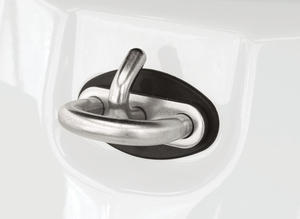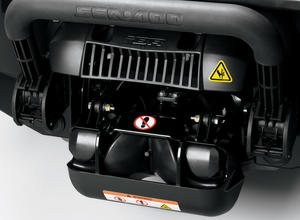2012 Sea-Doo GTX 215 Review
More potent engine highlights mid-level "luxury performance" model
What’s in a name? If you take a moment to ponder the Sea-Doo GTX 215, the answer is plenty.
Obviously it’s a GTX, the designation long given Sea-Doo’s premier luxury/performance flagship models. In 2012 that means it shares the same versatile S3 hull design that now characterizes much of the Sea-Doo line. It feels noticeably larger to those used to the old-school (2009 and earlier) GTX, but that size pays big benefits. It makes for a comfortable cruiser, certainly, but it also makes the craft much more capable in big-water. Internal ribs provide the guts to get the job done, but it’s craft’s deep-V design that now puts it squarely amongst its competitors as a craft that can handle almost any water condition.
But don’t go thinking that big-water confidence means it’s lost any of the GTX series’ trademark zip. On flat water, the hull carves with a precision that will delight performance riders, and give confidence to the newbie trying to advance his skills. Straighten those bars and point the boat in a straight line and the hull’s lightweight construction and speedboat-like step enhance both acceleration and top speed.
 Attach a skier or wakeboarder to this tow eye and you’ll have no trouble pulling them up and out of the water.
Attach a skier or wakeboarder to this tow eye and you’ll have no trouble pulling them up and out of the water.The other obvious component of the name is 215. Though touting horsepower numbers is suddenly taboo in the PWC world, it’s no secret that once upon a time Sea-Doo claimed this engine would crank out about 215 of those horses. That means it uses the same 1,494 cc Rotax engine found throughout the line, but bumps the power with the addition of a supercharger and intercooler to force feed that engine a spiked diet of cool air. That gives the GTX 215 a welcome kick, without pushing it fully into the ranks of the brand’s most elite muscle machines.
What kind of power do 215 horses (likely a little less in actuality given Sea-Doo’s past penchant for rounding up) produce? Enough to easily pull the waterskiers and wakeboarders in your crowd out of the water, power a solo rider to 30 mph in short order, and top out around the 65 mph mark in good conditions.
Below The Surface
 Drop the reverse gate and you can slow the GTX 215 down quickly.
Drop the reverse gate and you can slow the GTX 215 down quickly.Not so obvious from the name, but certainly obvious to those familiar with the brand, are the GTX 215’s amenities. And as any modern Sea-Doo fan can attest, those amenities start with all things iControl.
First up on the hit list is Intelligent Brake and Reverse (iBR). At its essence, it gives a Sea-Doo braking ability by linking a modified reverse bucket to a lever mounted on the left handlebar, and throwing a little computer control into the mix. Squeeze the lever and the computer stops thrust just long enough for the bucket to drop into place, then reapplies that thrust to provide a redirected flow of water to slow forward motion. Stopping distance is reduced by as much as 100 feet. The brake’s stern location, and a little influence from the iControl brain, prevents the bow from abruptly diving, meaning you get a controlled stop that is mostly dry and keeps the driver in his seat.
iBR also allows a Sea-Doo to start in a neutral mode, meaning no more surging forward at the dock or launch ramp. Squeezing the throttle lever then pushes the craft forward, squeezing the reverse/brake lever stops that motion or pushes the craft into reverse. It’s all very intuitive, and delivers a level of control that makes coming into a crowded area or docking in tight confines a piece of cake.
The other big element of iControl is Intelligent Throttle Control (iTC), or essentially electronic throttle. Removing the physical cable means engineers can do some cool things, like cruise control and no-wake mode, but it also allows for differing acceleration profiles. Touring mode provides a more subtle acceleration, Sport mode gives the user access to the engine’s full potential, and ECO mode finds the most fuel-efficient speed.
Bag o’ Tricks
 A hinged seat makes accessing the engine simple and hassle free.
A hinged seat makes accessing the engine simple and hassle free.Other notable features include a nicely bolstered, touring-style hinged seat that raises on gas struts for engine access, electronic trim, tilt steering, a full-featured info display, and a flip-down boarding step. One not-so-obvious miss is storage capacity. By borrowing the hull-and-deck design originally introduced on the brand’s suspension models, storage is significantly reduced, down to less than 14 gallons. Whether that’s a problem depends on what kind of rider you are…and what you like to bring along for the ride. Sea-Doo’s removable storage tub is handy and watertight, but it does add another level of complexity when trying to access the contents out on the water.
Style? The 215 version gets an attractive, upscale style for 2012, a bright white with subtle black accents and gold metallic highlights.
So that’s what’s in a name — a solid hull, spirited handling, strong power, and plenty of bells and whistles. Now you just need to decide if you can see your name on the title.
| Sea-Doo GTX 215 Specs | |
| Length | 139.2 inches |
| Beam | 48.2 inches |
| Dry Weight | 824 lbs |
| Engine | Supercharged with intercooler, three-cylinder |
| Displacement | 1,494 cc |
| Bore and Stroke | 100 mm x 63.4 mm |
| Compression Ratio | 8.4:1 |
| Rated Horsepower | NA |
| Fuel Capacity | 15.9 gal. |
| Combined Stowage Capacity | 13.7 gal. |
| Colors | Pure White with Gold |
| Price | $11,999 |
Related Reading
2012 Sea-Doo GTR 215 Review
2011 Sea-Doo GTX iS 215 Review
Get PersonalWatercraft.com in your Inbox!
Like PersonalWatercraft.com on Facebook
Comments
Most Popular

Remembering the Sea-Doo XP

2025 Yamaha JetBlaster PRO 2-Up Review

2024 Yamaha GP HO Review

2024 Kawasaki Jet Ski STX 160X Review

2008 Kawasaki Jet Ski Ultra 250X Review













 Your Privacy Choices
Your Privacy Choices